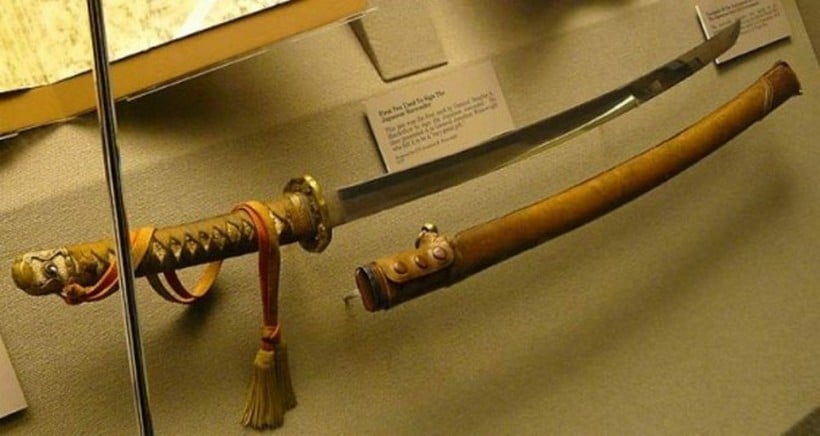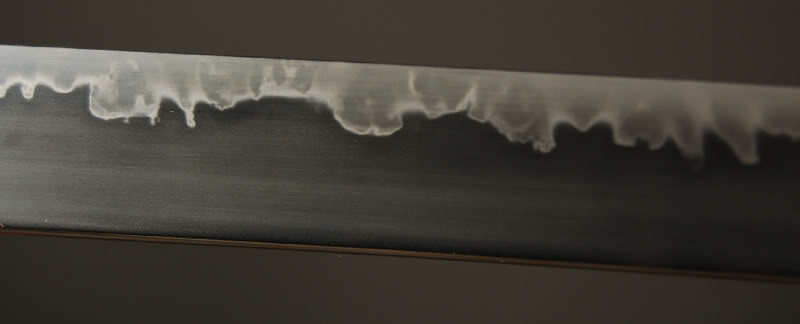By lyuesword | 12 April 2022 | 0 Comments
Decoding the Mystery of Japanese Swords
The Katana sword is considered the soul of the Samurai and one of sharpest weapons in the world, boasting both the ability to cut through armour and its incredibly unique craftsmanship. Japanese Art Specialist Yasuko Kido, talks us through her top five things to know about the much-loved Samurai Sword.

1.An ancient tradition
Swords were initially imported from the continent or forged by craftsmen who immigrated to Japan, and early examples have been found in ancient burial sites from the Kofun period (mid 3rd - 7th century). The main purpose of a sword was of course to be used as a weapon; however, it was also worshipped as a sacred object. The sword is one of the three imperial regalia objects said to have been given from the gods, and even today the sword is used for rituals and ceremonies at court and shrines.
2. Unique forging techniques
During the Medieval period (1185 - 1600), Japan was in a constant state of warfare between powerful warrior clans and there was a great need for strong swords in battle. Japanese swordsmiths developed the unique method of laminating different types of steel together to forge a blade. This technique gave the sword its strength and flexibility and created a much admired artistic effect on the blade.
3. Artistic qualities of Japanese swords
Japanese swords have a number of defining characteristics but one characteristic unique to each sword is the surface grain created by the laminating steel technique, which produces a unique colour and pattern. This pattern can be viewed best, when holding the blade up to a light source, where it reveals a ‘landscape’ on the surface, formed from wavy shadows, sharp gold lines and cloudy dots.

4. Intricate mountings
Japanese swords are traditionally stored in mounts comprised of various fittings; a custom-made wood scabbard decorated with lacquer, the hilt covered by a layer of skin (often shark skin) and wrapped in a silk cord, with a small metal piece inserted under the cord to help grip the sword. Metal fittings protect the blade and the handle is decorated with various designs. Each part is made by highly specialist craftsmen and takes days and extreme concentration to finish.
5. They are collectable
Japanese swords reflect the unique culture and spirituality of Japanese people. While the function of the swords has been lost, they are now appreciated as an art form in their own right. Global networks of collectors and dealers share their knowledge and study through society and conventions. In recent years, Japanese swords have gained popularity among women who were inspired by female warriors in video games and films. One notable example is the twelfth-century samurai warrior, Tomoe Gozen, who was the inspiration for the 2010 film of the same name. This has encouraged women to become more involved with the production and the culture surrounding these ancient swords.
Want a unique sword? Feel free to contact us:
Email: lyuesword@hotmail.com
Website: www.lyuesword.com
Custom Sword Page: www.lyuesword.com/Custom-Sword/customization-options/Create-Your-Own-Swords

1.An ancient tradition
Swords were initially imported from the continent or forged by craftsmen who immigrated to Japan, and early examples have been found in ancient burial sites from the Kofun period (mid 3rd - 7th century). The main purpose of a sword was of course to be used as a weapon; however, it was also worshipped as a sacred object. The sword is one of the three imperial regalia objects said to have been given from the gods, and even today the sword is used for rituals and ceremonies at court and shrines.
2. Unique forging techniques
During the Medieval period (1185 - 1600), Japan was in a constant state of warfare between powerful warrior clans and there was a great need for strong swords in battle. Japanese swordsmiths developed the unique method of laminating different types of steel together to forge a blade. This technique gave the sword its strength and flexibility and created a much admired artistic effect on the blade.
3. Artistic qualities of Japanese swords
Japanese swords have a number of defining characteristics but one characteristic unique to each sword is the surface grain created by the laminating steel technique, which produces a unique colour and pattern. This pattern can be viewed best, when holding the blade up to a light source, where it reveals a ‘landscape’ on the surface, formed from wavy shadows, sharp gold lines and cloudy dots.

4. Intricate mountings
Japanese swords are traditionally stored in mounts comprised of various fittings; a custom-made wood scabbard decorated with lacquer, the hilt covered by a layer of skin (often shark skin) and wrapped in a silk cord, with a small metal piece inserted under the cord to help grip the sword. Metal fittings protect the blade and the handle is decorated with various designs. Each part is made by highly specialist craftsmen and takes days and extreme concentration to finish.
5. They are collectable
Japanese swords reflect the unique culture and spirituality of Japanese people. While the function of the swords has been lost, they are now appreciated as an art form in their own right. Global networks of collectors and dealers share their knowledge and study through society and conventions. In recent years, Japanese swords have gained popularity among women who were inspired by female warriors in video games and films. One notable example is the twelfth-century samurai warrior, Tomoe Gozen, who was the inspiration for the 2010 film of the same name. This has encouraged women to become more involved with the production and the culture surrounding these ancient swords.

Here the twelfth-century samurai warrior, Tomoe Gozen is a perfect example of the heroine admired by many across the world.
Want a unique sword? Feel free to contact us:
Email: lyuesword@hotmail.com
Website: www.lyuesword.com
Custom Sword Page: www.lyuesword.com/Custom-Sword/customization-options/Create-Your-Own-Swords
Leave a Reply
Your email address will not be published.Required fields are marked. *